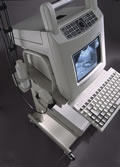Medical Ultrasound Imaging
Sunday, 19 May 2024
'Disk Storage' p2 Searchterm 'Disk Storage' found in 7 articles 1 term [ • ] - 3 definitions [• ] - 3 booleans [• ]Result Pages : •
(PACS) A system used to communicate and archive medical imaging data, mostly images and associated textural data generated in a radiology department, and disseminated throughout the hospital. A PACS is usually based on the DICOM (Digital Imaging and Communications in Medicine) standard. The main components in the PACS are: acquisition devices where the images are acquired;
•
short and longer term archives for storage of digital and textural data;
•
a database and database management;
•
diagnostic and review workstations;
•
software to run the system;
•
a communication network linking the system components;
•
interfaces with other networks (hospital and radiological information systems).
Acquisition devices, which acquire their data in direct digital format, like a MRI system, are most easily integrated into a PACS. Short term archives need to have rapid access, such as provided by a RAID (redundant array of independent disks), whereas long term archives need not have such rapid access and can be consigned, e.g. to optical disks or a magnetic. High speed networks are necessary for rapid transmission of imaging data from the short term archive to the diagnostic workstations. Optical fibre, ATM (asynchronous transfer mode), fast or switched Ethernet, are examples of high speed transmission networks, whereas demographic textural data may be transmitted along conventional Ethernet. Sophisticated software is a major element in any hospital-wide PACS. The software concepts include: preloading or prefetching of historical images pertinent to current examinations, worklists and folders to subdivide the vast mass of data acquired in a PACS in a form, which is easy and practical to access, default display protocols whereby images are automatically displayed on workstation monitors in a prearranged clinically logical order and format, and protocols radiologists can rapidly report worklists of undictated examinations, using a minimum of computer manipulation. •  From Philips Medical Systems;
From Philips Medical Systems;'A perfect portable system... The SD 100 is a system designed to travel. Weighing only 10.5 kg and battery or mains operated, the SD 100E is a full-featured ultrasound unit with a comprehensive software package, nine-inch monitor, digital output and built-in diskette for software updates and image storage. The SD 100E user can choose from seven linear and convex array dual frequency probes to perform many ultrasound examinations, quickly and reliably.' This product is not available in the US, Australia, or New Zealand from Philips Medical Systems. Specifications for this system will be available soon. Result Pages : |
Medical-Ultrasound-Imaging.com
former US-TIP.com
Member of SoftWays' Medical Imaging Group - MR-TIP • Radiology TIP • Medical-Ultrasound-Imaging
Copyright © 2008 - 2024 SoftWays. All rights reserved.
Terms of Use | Privacy Policy | Advertise With Us
former US-TIP.com
Member of SoftWays' Medical Imaging Group - MR-TIP • Radiology TIP • Medical-Ultrasound-Imaging
Copyright © 2008 - 2024 SoftWays. All rights reserved.
Terms of Use | Privacy Policy | Advertise With Us
[last update: 2023-11-06 01:42:00]




